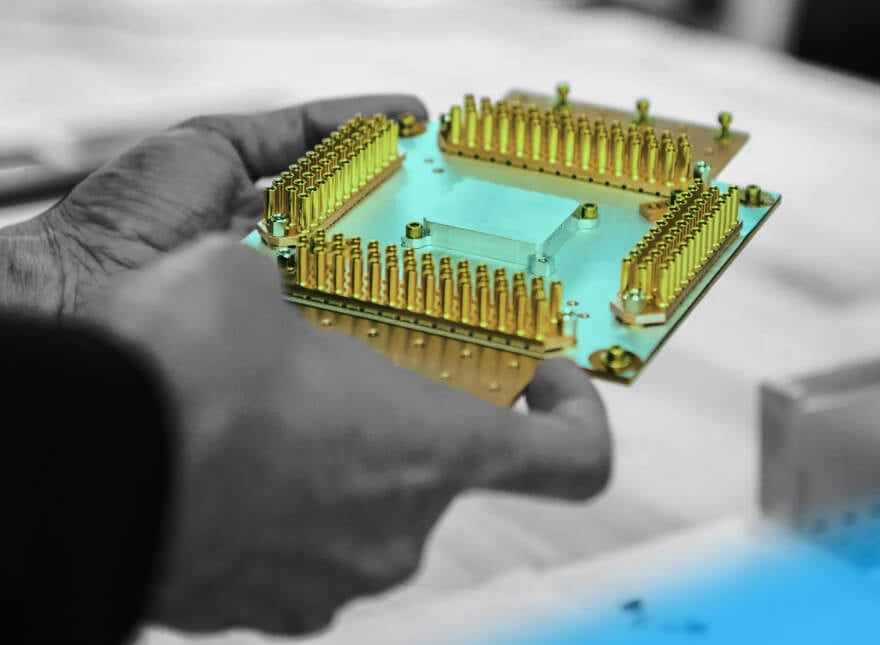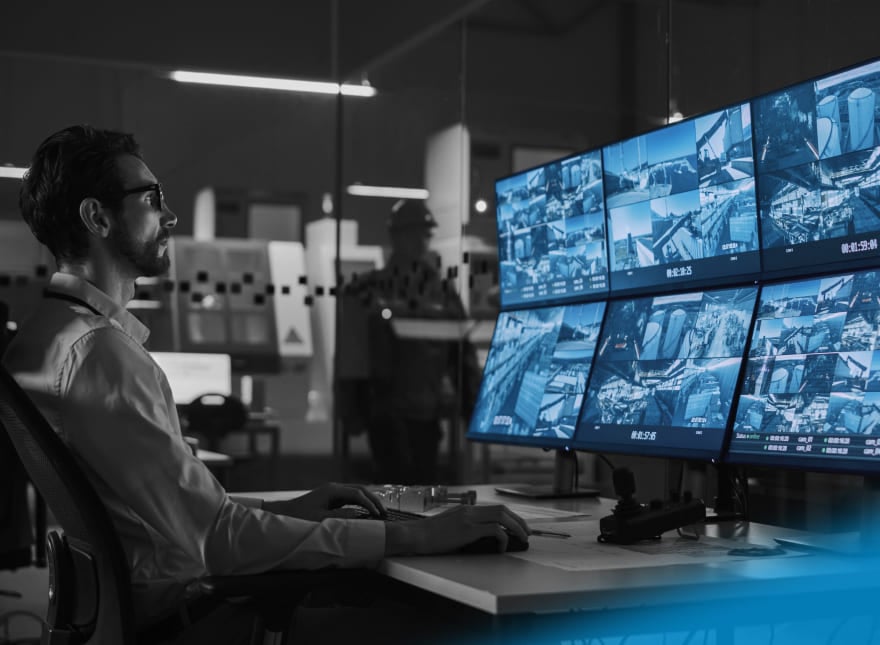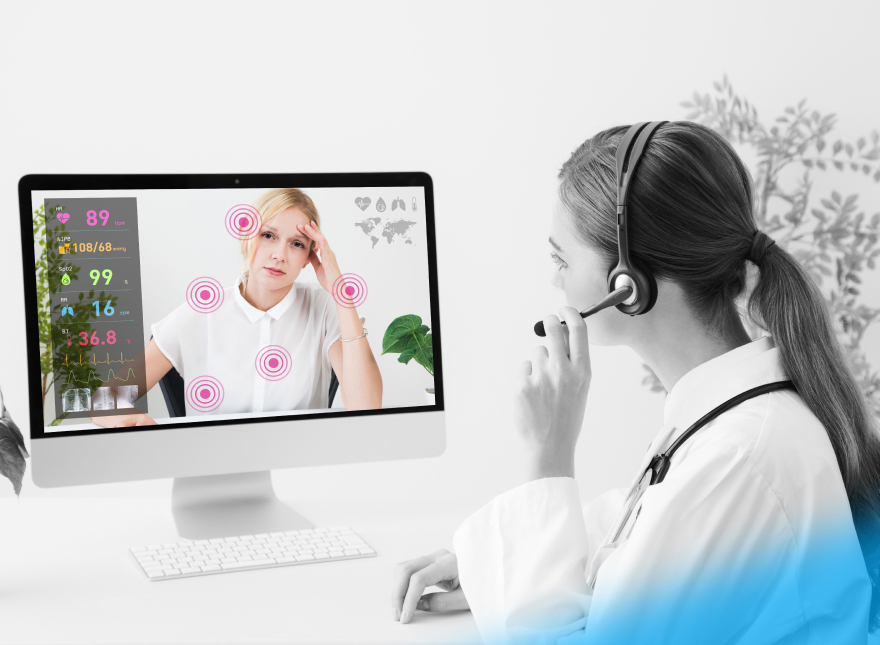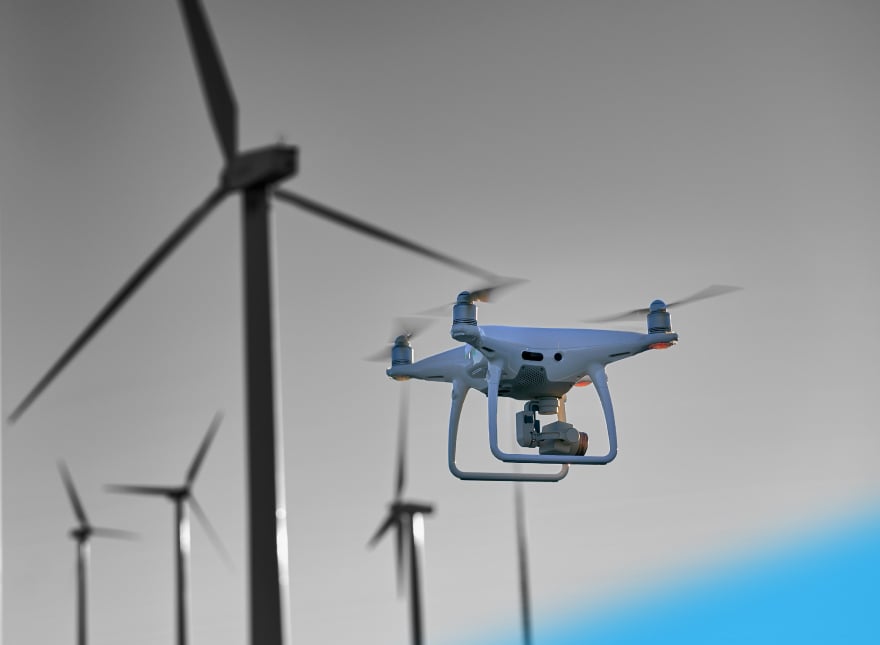Check out our latest blog article: From component to enterprise – modular robotics done right.
Consumer Electronics Trends and Examples for Startups to Look Out For
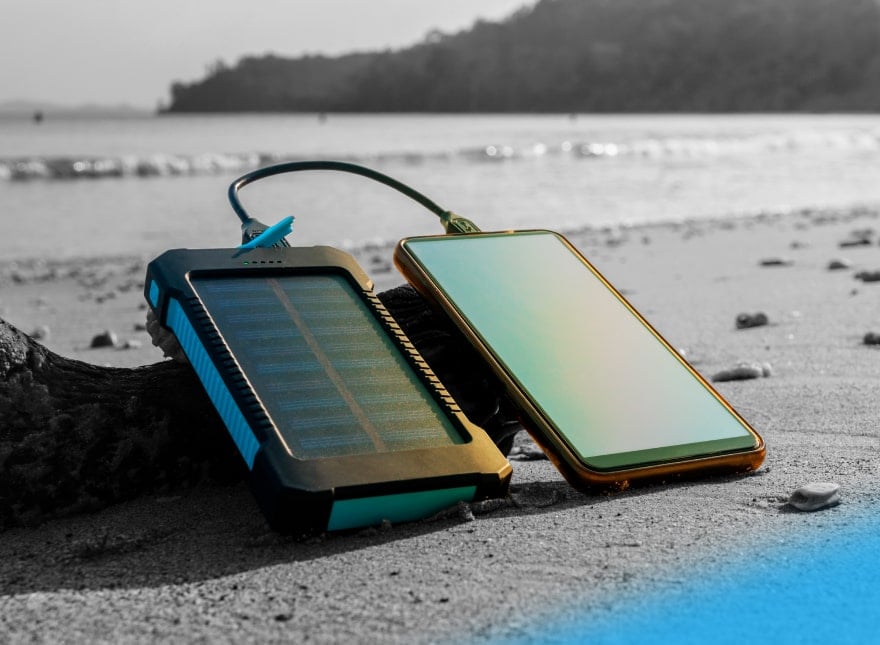
This is John. He believes in technology and that it makes his life more effective and environmentally conscious. John has dozens of consumer IoT gadgets that help him live in a smart way. His mattress analyzes his sleep behavior and adjusts firmness to improve comfort. Smart sneakers track his fitness progress and provide an optimal workout plan through an app. A portable solar generator supplies a toaster with energy so that John can prepare his breakfast using less electricity.
Nobody has to be like John, but more and more people are willing to be. A variety of consumer IoT examples are here to facilitate these lifestyle choices. For startups, this means that working on smart devices is now a breeding ground for success.
This article is an overview of the trending application areas for consumer electronics startups. We’ve compiled key trends driving the industry. You’ll also find some inspiring examples of how companies can capitalize on these consumer electronics trends. Many of the startups we mention below have already been successful in terms of money and recognition. Your project can be next.
Overview of Consumer Electronics Market Trends
The consumer electronics industry market is growing slowly but steadily. According to Precedence Research, the global market size will grow from $724.5B in 2021 to $1.1T in 2030.
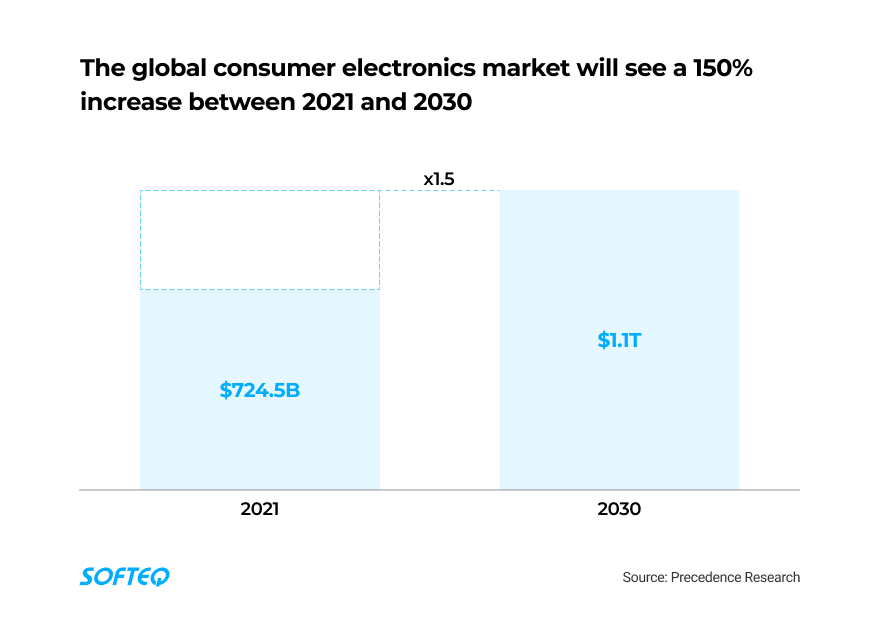
People who want to live easier, healthier, and safer lives drive the demand for consumer IoT devices. To meet this demand, startups now have more tech advances at their disposal than ever before. Take a look at the triggers that have made an impact and will further influence the industry:
- Access to more tech advances. By this, we mean wider adoption of AI and robotics, smaller and cheaper hardware, and all-round connectivity with appealing 5G. A huge volume of collected data and a growing network infrastructure to process this data can be at your disposal.
- Shift to home automation. Consumers are shifting toward smart homes to live more convenient and safer lives. They are more interested in solutions with voice assistance, Bluetooth, and Wi-Fi than ever. Plus, they have more opportunities to afford it. In the US in 2021, the real median household income was almost $71K, which is 140% higher than 10 years ago.
- Growing focus on health and fitness. Pandemic lockdowns forced many people to stay at home. This meant there was a need for gadgets that help doctors remotely monitor their patients. Examples are medication trackers, wearable patches, and AI robots in nursing. Stay-at-home restrictions also made solutions for home workouts more popular. The pool of ideas can be never-ending here. You might have heard of smart yoga mats or interactive fitness mirrors, for example.
- Green concerns. Studies reveal that more consumers have become environmentally conscious. They choose sustainable products and change their lifestyle to protect the environment. They buy eco-friendly gadgets even if these products cost more. For manufacturers, this creates an entire niche for building solutions with sustainability in mind.
- Growing investment. Investors haven’t stopped pumping money into the consumer electronics market. According to Crunchbase, in 2022, startups raised almost $3.4B—that’s over 2.5 times more than three years ago. Also, tech giants are actively pouring money into research and development (R&D) initiatives. For example, in 2021, Philips spent €1.8B on R&D to boost health innovations in healthcare.
Now, let’s take a look at how startups can use these trends to conquer the market. Here are the most promising consumer IoT use cases with real-life examples included.
Idea 1. Smart Devices for Health and Wellness
We are seeing a rising demand for connected healthcare devices. These range from medication trackers and wearable patches to telepresence robots. COVID-19 was instrumental in boosting the need for remote monitoring and telemedicine. Some ideas are really imaginative, like the U-Scan. This is a urine scanner that can be used in toilets. It can check for health problems related to the digestive and reproductive systems.
Wellness also remains a hot topic, with solutions to manage stress and well-being. One example is the Nowatch, a smartwatch that doesn’t display the time. Instead, it uses heart rate, sweat, and body movements to send vibrations that help reduce stress and lift the mood. Meanwhile, wearables in sports activities can watch health parameters and track athlete performance. They come in the form of fitness bracelets, headsets, or even smart vests.
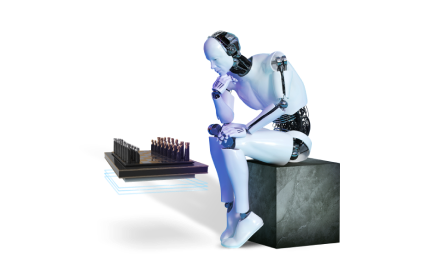
Real-Life Example. Smart mattresses are gaining popularity. One such example is the ANSSil Sleepinbody Mattress, a mattress from Korean startup ANSSil. It watches the user’s sleep patterns, including postures and behaviors. Then it analyzes this data and adjusts the temperature level and firmness of the mattress for better sleep.
The ANSSil mattress has been in focus at CES for two years in a row. In 2022, it received the CES Innovation Award in the smart home category. Earlier this year, the mattress was recognized as an innovative product in the digital health, home appliances, and smart home categories.
Idea 2. Baby Tech Solutions
Today, baby tech products are gaining momentum across the consumer IoT. Tech-savvy millennials already assign a portion of their tasks to digital solutions, so it makes sense that they’d also do so when it comes to caring for babies.
The demand for baby tech has become even higher since the pandemic because offices have reopened and more babies have been born. Young US parents are more likely to be able to afford digital solutions than ever before. Millennials who are already growing their families have more than doubled their total net worth recently. So what is on the market for them?
Baby tech startups offer products for two main types of target audiences—expecting parents and families raising children. Those in the first group may want to use fertility and pregnancy trackers, such as a thermometer that analyzes basal body temperature or a smart bracelet that tracks fertility.
For pregnant women, there are fetal dopplers that listen to a baby’s heartbeat.
A popular device for the second group is a remote baby monitor. These enable parents to monitor their children’s well-being and whereabouts. An example is a Q-bear, an AI baby monitor that promises to translate what a baby is crying about. You can also find smart car seats, GPS trackers in the form of clips and watches, and self-driving strollers on the market.
Real-life example. Take a look at Ella. It’s an AI-powered stroller created by Glüxkind, a Canadian baby tech startup. The stroller comes with adaptive push and brake assistance, which lets it tackle inclines and declines with ease. What’s more interesting is that Ella comes with self-driving capabilities. It’s possible to activate hands-free strolling when a child isn’t in the stroller. Additionally, Glüxkind’s solution has a “rock-my-baby” mode to provide a soothing motion.
Ella showcased at CES this year, and the stroller was named as an Innovation Awards Honoree at the show.
Idea 3. Pet-related Tech Gadgets
The pandemic resulted in a so-called puppy boom, and these days, two-thirds of US households have pets. A new wave of pet-friendly gadgets brought smart collars, smart feeders, and dog-activated video calls to the market. There are even smart solutions for watching wildlife. Take a look at Bird Buddy, an AI-powered bird box that records birds and identifies species.
The boom of pet-related tech spreads far beyond pet care solutions. For example, there are robotic toys that act as companions for different groups of people. These can be helpful for working with socially isolated seniors or in robot-assisted therapy in pediatric treatment. A good example is Sony’s AI-powered puppy, Aibo—a robotic companion that aims to relieve stress. Owners can name their robot, witness its growth, and teach it tricks.
Real-life Example. PAWS is a US developer of advanced pet safety technology and one of our customers. They created a Halo collar, a wireless smart fence for dogs. The solution creates virtual fences, helps prevent pets from leaving a designated area, and brings them back to safety. With a GPS tracker, owners can track their dog’s location when it’s wearing the collar. It’s also possible to watch the dog’s movements between indoor and outdoor spaces.
Find Ken Ehrman, founder and managing partner at Halo Collar, on the Forging the Future podcast. He recalls the journey to making the collar a successful product, with all its ups and downs:
Idea 4. Devices for the Metaverse
The metaverse makes headlines again and again. VR and AR were already benefiting various business areas, and now they are at the heart of the metaverse. Entertainment and sports are just two areas that use these technologies. Entertainment firms can make their events eye-catching with AR, and sports clubs can engage with their fans with the help of VR. An example is a virtual stadium tour. But today, XR (comprising AR, VR, and MR) is a driving power for a whole digital world that exists parallel to physical reality.
Today, metaverse users attend virtual concerts with their friends, play games, and even buy and sell virtual real estate.
To enter the metaverse world, you simply need a VR headset with hand-operated controllers. Sensors, cameras, and microphones can be used to bring objects from the real world into the virtual one. Microsoft HoloLens is a vivid example. It’s one of the well-known metaverse devices for augmented reality. Interestingly, solutions for the metaverse aren’t limited to smart headsets. The following example comes as proof.
Real-life example. Shiftall is a Panasonic-owned company with a focus on IoT development. They created Pebble Feel, a wearable device for heating and cooling users in the metaverse. Depending on their virtual location, a user can control the temperature from 48°F to 107°F and feel the temperature change. Pebble Feel is a 60-gram device in the form of a small rounded pebble that can be attached to a shirt. It can be used with SteamVR apps for experiencing VR content. In the meantime, manufacturers say it can also be used outside of the metaverse as a personal air conditioner.
Idea 5. Solutions for Sustainability
Startups focused on green tech now have lots of options for their solutions. We can consider the growing number of gadgets as proof. For smart homes, there are devices that cut water use and electricity bills, and systems that generate and conserve energy. Meanwhile, those living in urban areas have got electric bicycles and charger stations for them.
There’s a group of products that has invaded the market in recent years: portable power storage devices. These products range from small power packs to power stations that can generate solar energy from a rooftop. Some of them target campers, for example, with portable wind power generators or power stations with internet connection.
You can even get tents equipped with solar panels.
Real-life example. Jackery is a US-based energy company with a focus on solar energy. They created Jackery LightTent-AIR, an inflatable tent for outdoor camping with room for up to five people. The tent is made of waterproof and flame-retardant fabric. More importantly, it can produce energy. The tent has built-in gallium arsenide solar panels that can generate up to 1,200W of power during the day. That’s enough to charge devices once the sun goes down. It’s also possible to connect the panels to a separate external battery.
Jackery has won the Innovation Awards at CES 2023 with its tent and plans to start selling it in two years.
Consumer IoT Startups that Received Funds and Awards
According to Crunchbase, investors poured $17.9B into consumer electronics startups in 2022. Consider Mila Cares, a San Francisco-based startup and one of the funding leaders from 2022. The company first showed up on Kickstarter with its smart air purifier three years ago. The device has filters for pet odors, allergens, urban smog, and home renovation dust. The smart solution detects humans in the room and notifies them about the air quality status via the mobile app. In 2022, the company raised its $10M round in an all-equity deal at a $52 million post-money valuation. The seed round was led by Electrolux, and Mila Cares is its first venture investment.
The following are other promising startups that raised funds last year, according to Crunchbase:
- Leia’s 3D Lightfield displays. They allow users to interact with 3D images on the screen without glasses, enabling them to play a game or have a 3D chat with friends.
- Zendure, with its portable power stations. They can charge laptops, drones, mini-fridges, and even Teslas.
- Smoodi, a robotic smart smoothie machine for restaurants, stores, and offices
- Hindsight Optical, with its rear-view cycling glasses that allow users to see approaching traffic from behind.
Consumer tech products receive both investments and awards. Every year, CES honors tech innovators creating wearables and solutions for smart homes, digital health, and sustainability. Some of the 2023 honorees include
- AVEIR VR Leadless Pacemaker from Abbott. It’s used to treat patients with slow heart rates. The device is implanted inside the heart’s right ventricle with no need to incise the chest.
- Motion Pillow 2023, a smart pillow that tackles snoring from 10minds. It’s equipped with a motion system that recognizes when a user starts snoring. Then, it injects air into the built-in airbag and pushes the user to turn their head.
- TTcare, an AI-power pet care app from AI FOR PET. A pet owner takes a photo of their dog or cat; then, AI software analyzes the image to check for potential eye, skin, or joint-related diseases.
If you’re new to the consumer electronics industry and are looking for how to boost your early-stage startup, Softeq Venture Studio is here to help. We’ll assist you with business skills, tech expertise, and even finance. Softeq is often the first investor in a company. At CES 2023, two Softeq Venture Studio portfolio companies from the 2022 cohorts conquered the expo hall.
One of them is Motusi. They created a whole-body wearable that generates insights related to body movements and then helps athletes progress in their performance or recovery. The solution features an AI mobile app and avatars to communicate how a body is moving in 3D space. This enables coaches to offer athletes advice for efficient injury recovery and performance improvement. With the data stored in the cloud, it’s possible to analyze user performance over days and months. Marc Alexander, the founder of Motusi, came up with the idea after getting into a car accident. He explains how the studio helped boost the early-stage startup:
The other company is Vela Bikes. Vela Bikes is a New York-based e-bike company making smart bicycles with a removable battery, GPS, Bluetooth, 4G sim card, and USB charging port. Bikes come with a mobile app for navigation and a remote control.
Case Closed
These are exciting times for consumer tech startups. Customers want to live convenient, safer, and greener lives. The growing pool of smart gadgets is becoming the new normal. Tech affordability, greater investments, and customer demand are helping companies build what the market actually needs. The main challenge here is to define your competitive advantage. Softeq can help you find the right niche and build a solution that will skyrocket!
More articles on the topic


